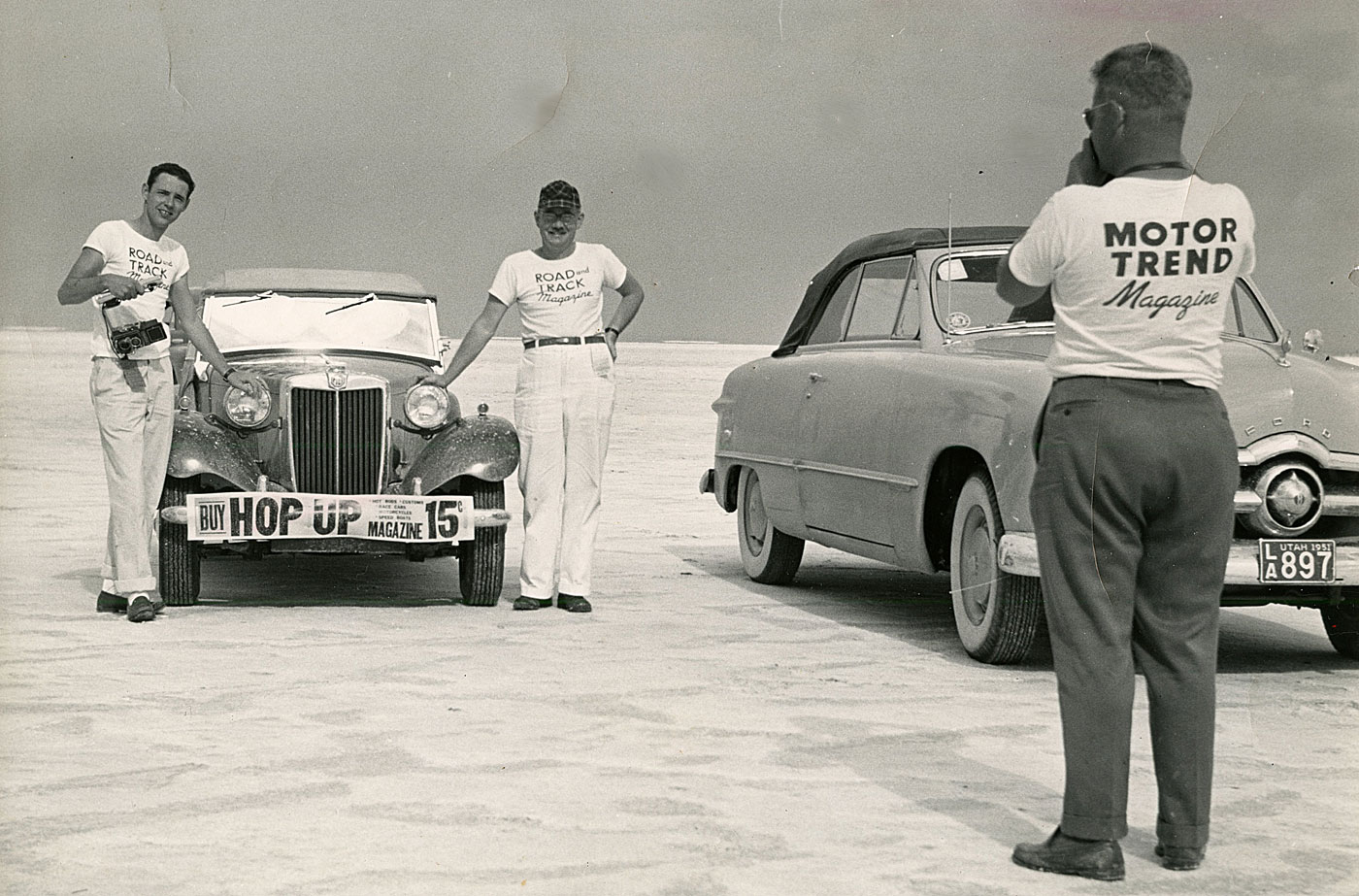
Off to a great start: Bonneville, 1951. Road and Track, Hop Up, and Motor Trend staff members gather for the Bonneville Speed Week. Jerry Cheseborough is on the far left, that might be Oliver Billingsley on the other side of the MG. Motor Trend photographer unknown. Courtesy Jim Sitz.
By Pete Vack and Jim Sitz
Ed. note: Most of the information below was provided by historian Jim Sitz, who was a witness to the early years at the magazine, via emails to me over a period of weeks in 2020. He also was in the possession of the rare photos taken at the Road & Track offices in 1951, obtained from the Billingsley collection in the early 1990s. We have not been able to determine who took these photos or under what circumstances. Any questions regarding these photos can be sent to the Editor at vack@cox.net.
You Bet Your Life
In 1952, while Groucho Marx was gambling his future on the new-fangled TV with a show called “You Bet Your Life”, a thirty-nine-year-old engineer in California with a bright, enthusiastic wife, a new son and a MGTC was betting that the sports car fad was here to stay. In fact he was betting his family’s entire future on a sports car magazine that was deeply in hock. It had been offered to other magazine publishers but turned down, and one wouldn’t even take Road and Track (no ampersand in the early days; the “&” in the title was introduced in 1954) for just the bills. But staff members John and Elaine Bond were determined to save the magazine and were fully aware of its potential of a magazine devoted to the growing sports car movement. They decided to take a huge risk.
Although the Bonds were always closely associated with the success of Road and Track, they didn’t establish the magazine. Writing in R&T, June, 1972 Bond recalled those early years. “Many readers seem to think that Elaine and I founded Road and Track, that isn’t true, we merely kept it from foundering when we took it over in November of 1952.” No one ever seemed to ask who did, until in 1998, automotive historian and fact checker Jim Sitz decided to take the time and trouble to find out how it all began. He tracked down Bill Brehaut who was living in Palm Springs, California.
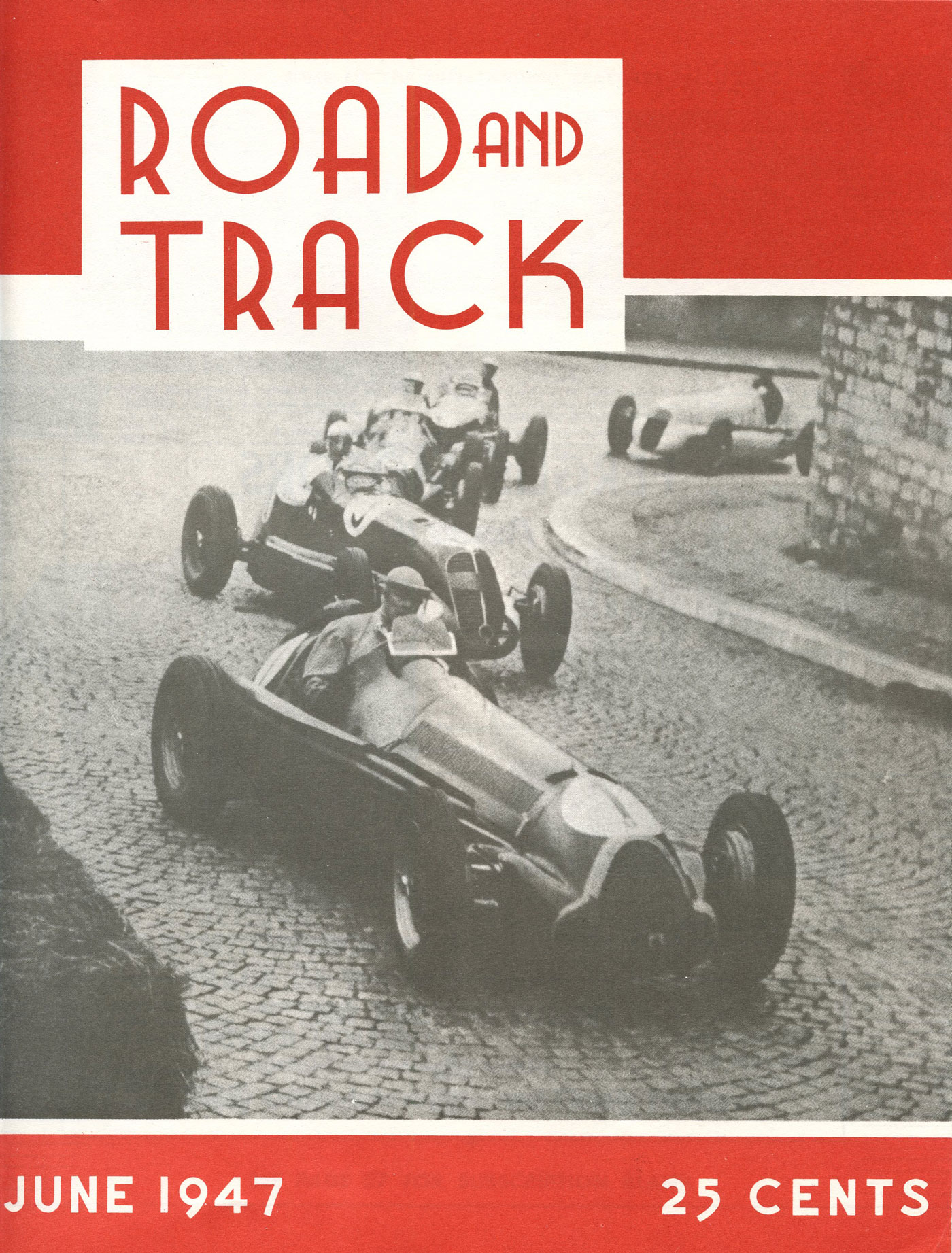
Volume 1 Number 1 featured the Alfa 158. In the time period from 1952 through 1972, Road & Track ranked in the top five among automotive titles that provided circulation details. It started with a monthly print volume 18,600 and grew to 64,000 in 1975 (a compound annual growth of 6.3%). It competed with Motor Trend, Hot Rod and Car and Driver. But in the early years, would-be angels like Tommy Lee and Secondo Guasti bailed out, as they saw no future in the new magazine and were surprised it did survive at all!
Brehaut et Fennessy
William Brehaut, Jr. was an engineer who worked for Republic Aircraft out of Long Island and a car enthusiast. In early 1947, he realized the potential for a magazine about foreign and domestic cars, as well as racing. Teaming up with Joseph S. Fennessy, Brehaut put together a very slim magazine of only 32 pages, and named it Road and Track. Sitz recalls that Brehaut only had money to print one issue. “They printed a few thousand copies of Volume 1 number 1 for June, 1947, and sent one half to New York City and the other half to Los Angeles.” That wasn’t the way to attract the large numbers of subscribers (for only $3.00 a year) and at 25 cents per copy, printing and postage costs were probably nowhere near covered. But traditionally, magazines needed a huge cash investment to get them through the first few years. That was something Brehaut did not have.
Then, Brehaut moved to Burbank to work for Lockheed and took the magazine, such as it was, with him. Once in California, Oliver Billingsley came to work for the magazine for free to keep it going and worked for free, as Billingsley had a military pension to live on.
It took almost another year to produce Volume 1 number 2. Despite the help of Billingsley and a new “Report from Europe” by dealer/writer/racer Roger Barlow, the editorial sounded dire. “It is vital that enthusiasts support Road and Track in this difficult period by sending us their subscription NOW.” (sic) After having sent $3 almost a year before with no issues forthcoming, car enthusiasts could not be blamed for ignoring the editor’s pleas.
But there was a lot of interest. Letters poured in with the same message, “Road and Track is what I’ve been waiting for…” In the magazine’s editorial for May 1948, it was noted that “Everyone seemed to want more and more of the pictures of European road racing and advance passenger cars…The development and growth of all American ‘sport car organizations’ is to be assisted in every manner possible.”
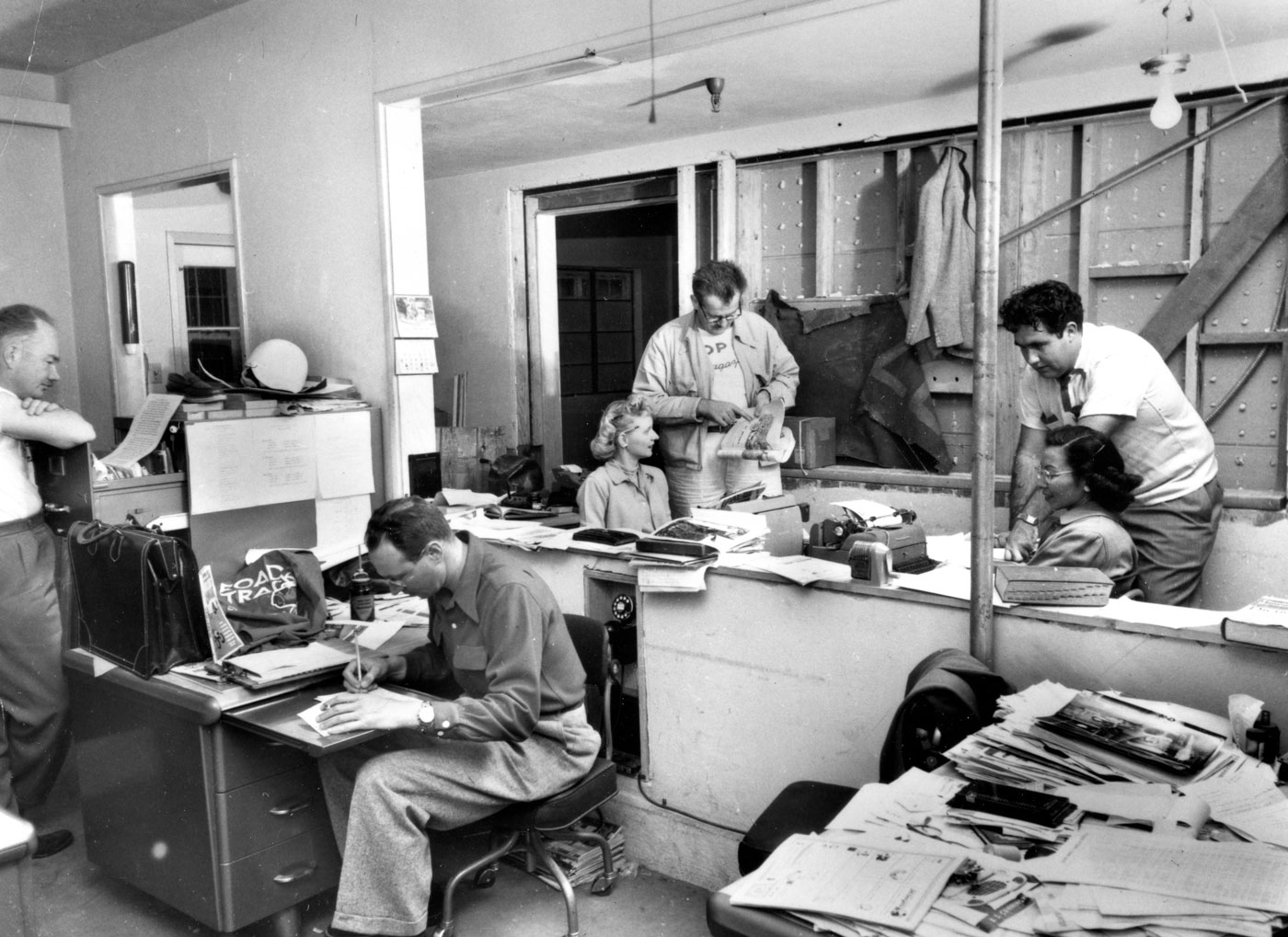
Rare photos of R&T’s first office in Glendale, California. Oliver Billingsley can be identified with the R&T shirt and mustache, Bob Dearborn is standing up next to the office lady. The date is November 1951 and as you can see, the office is very crowded, probably squeezed between two printing offices at the 540 West Colorado Blvd address. – Jim Sitz
The tiny, largely unpaid team managed to put out another issue the very next month, and it featured an article entitled, “What is a Sports Car” by John Bond, who worked just down the street from the office at Kurtis-Kraft. While the sports car had been defined by the British prior to the war, Bond knew that Americans would simply identify a sports car as a convertible. “The reason for this reply, he wrote, “is readily apparent. It is that no sports cars have been made in this country since the days of the Stutz, Mercer, and more recently, the Duesenberg.” The influx of British sports cars to the U. S., according to Bond, caused many people to wonder why similar cars were not made in America. But the term needed clarification, so Bond, an early member of the SCCA, sent out 200 questionnaires to have the member take a shot at defining a sports car. Summing up the many and varied responses, Bond wrote, “A sports car is a car between a racing car and a production car,” which meant that almost anything goes. And perhaps, it was loosely defined in order to draw more people to the pages of Road and Track.
Dawn of the Bonds
The magazine struggled on; June was followed by August and then a lapse until February, 1949, when Bond appeared on the masthead as an associate editor, opposite Brehaut. But things went from bad to worse. No monthly issues were mailed to those hopeful subscribers for the rest of 1949. Finally, in December of 1949, Road and Track once again appeared on newsstands. In the January 1950 issue, a reader wrote, “I subscribed a year ago and have received only two issues. My year’s subscription is up now; at this rate each copy cost me $1.50! Kinda expensive!”
Again the editorial had to answer the question of what happened to Road and Track? In a word, finances. According to Sitz, “Brehaut had offered the mag to Fawcett Publications in New York for free if he could stay on as editor but they turned him down. In an attempt to keep it afloat, in 1950 the price was raised to 35 cents an issue and the yearly subscription to $3.50 but by this time, Brehaut gave up on the magazine.
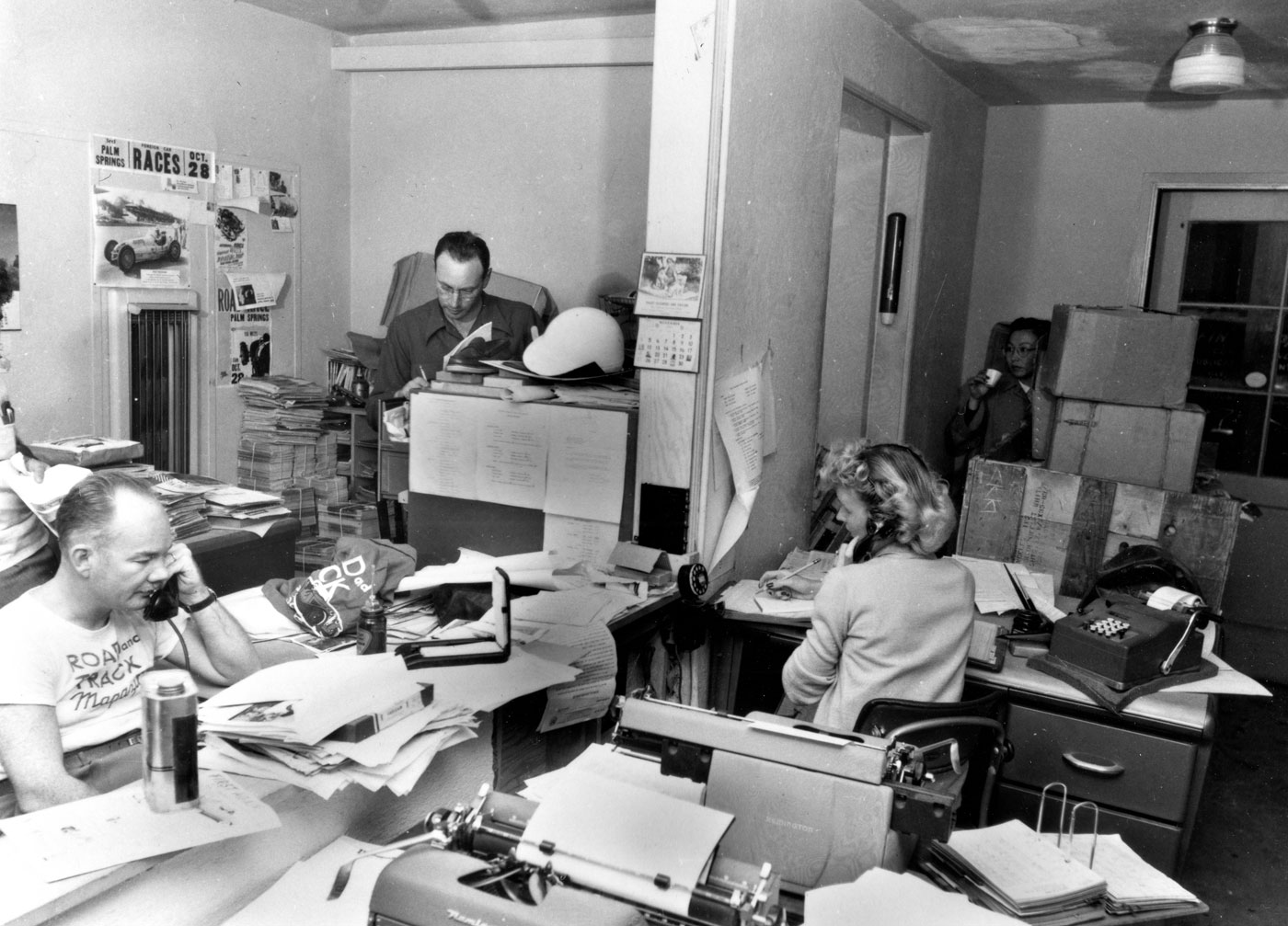
Another view of the Road and Track working space. 1951 was a big year for the team at Road and Track. They actually produced 12 issues in a year. But it would take John and Elaine Bond to get the magazine out of hock.- Jim Sitz
Oliver Billingsley was now in charge and from 1950 on, they produced an issue almost every month from then on. Bond became the Technical Editor, and Brehaut stayed on the staff as well. Money was coming in but printing costs and mailing were still escalating. Their credit was no longer good with the printer, who was located next door! Something had to give. Brehaut was eased out of his position. He had just 22 per cent ownership, and some was sold to Henry Manney early on, and associate editor Bill Quinn, whose mother loaned him $5000 to “rescue him from loading baggage at airport,” as Sitz recalls. “Quinn’s mother also bought Bill a new Jaguar too, and was the envy of all of us.”
In 1952 the printer, who by then effectively owned the magazine due to unpaid bills from previous editions having caused deep indebtedness, said it could have no more credit. To save the fledgling magazine and secure its future, John Bond reportedly agreed to sign a promissory note for 80,000 dollars (roughly $800,000 today) and took control of the magazine. Whatever the amount, it was up to the Bonds to make the magazine succeed and work off the debt. They would then own the magazine. The staff was fired, opening the door to young freelancers, but it was still tight. Those were scary days, but Bond maintained his sense of humor and he joked about his massive note to his young friend, Jim Sitz, “Hey that’s eight Ferraris.”
Bond thought they were lucky but it was a lot of hard work. “In 1952 we had just six employees. Everyone doubled. The receptionist, for example, took all the calls, took care of the 3000 subscribers, and did most of the bookkeeping.”
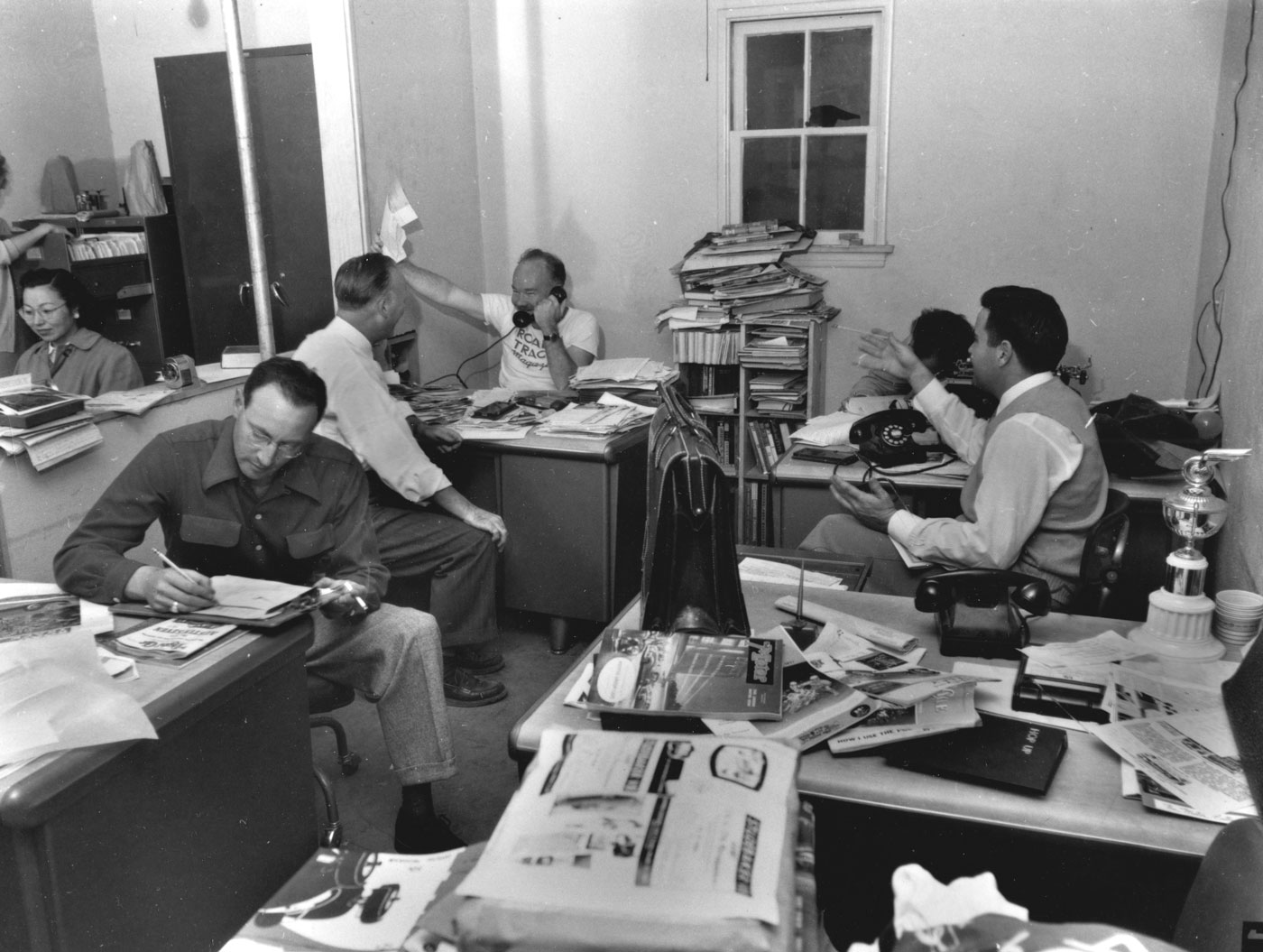
The last of the rare 1951 office photos obtained from Oliver Billingsley’s wife in the late 1990s. Perhaps readers can help identify the other people in the photo. We believe that the man in the dark shirt is ad manager Sam Weil.
Now out of the magazine business, Brehaut moved to San Diego in 1953. Sitz recalled that “Brehaut found a job at Consolidated Aircraft and in the following years, imported many intriguing Italian cars for re sale, and of course, placed the ads in the new classified section of his old magazine.”
In new hands the circulation grew. Bond wrote that the growth “…wasn’t spectacular but it was steady.” The gamble was paying off.
Part 2: The Bonds take over
John and Elaine Bond’s son John Jr. and daughter Lee tell us about their parents. Stay tuned!
Road and Track issues and covers from 1947 to 1952 courtesy Jim Sitz:
1947
JUNE 47 ALFA GP CAR
1948
MAY 48 TALBOT LAGO
JUNE BLUE CROWN INDY CAR
AUGUST MIDGETS AT ROSE BOWL
1949
FEB 49 DELAHAYE AT CIROS CLIUB
DEC 49 EDWARDS SPECIAL
1950
JAN NARDI OF JOHN EDGAR
FEB BRM 16
MARCH CISITALIA
APRIL ROVER TURBINE
MAY BALDWIN SPEC
JUNE NOVI INDY CAR
JULY/AUG 4 SCENEES OF BRIDGEHAMPTON
SEPT FERRARI GP
OCT CADILLACS AT LE MANS
NOV COLOR! SAOUTCHIK BODIED CADILLAC
DEC SAOUTCHIK RENDERING
1951
JAN STORY SPECIAL
FEB BRASS RAD CADILLAC
MARCH BLUE ALFA COUPE FARINA
APRIL MG TD RED
MAY 4 FRAMES MORRIS, MG RILEY, SIMCA
JUNE RENDEREING MODERN MERCER
JULY FERRARI OF KIMBERLY ALFA 2900 OF PHIL HILL
AUG TALBOT LAGO BLUE CAB,
SEPT MERCEDES 540
OCT ALFA 2900 OF DR FARINA
NOV BUGATTI GP CAR
DEC STUNNING NIGHT SCENE OF TALBOT LAGO COIUPE
Road & Track addresses from 1951
1951 THRU 56
540 W. Colorado Blvd, Glendale CA
1957 THRU 59
8244 Vista Del Mar, Playa Del Ray CA
1960 TO 1962
834 Production Place
Newport Beach CA
1963
1499 Monrovia Ave
Newport Beach CA

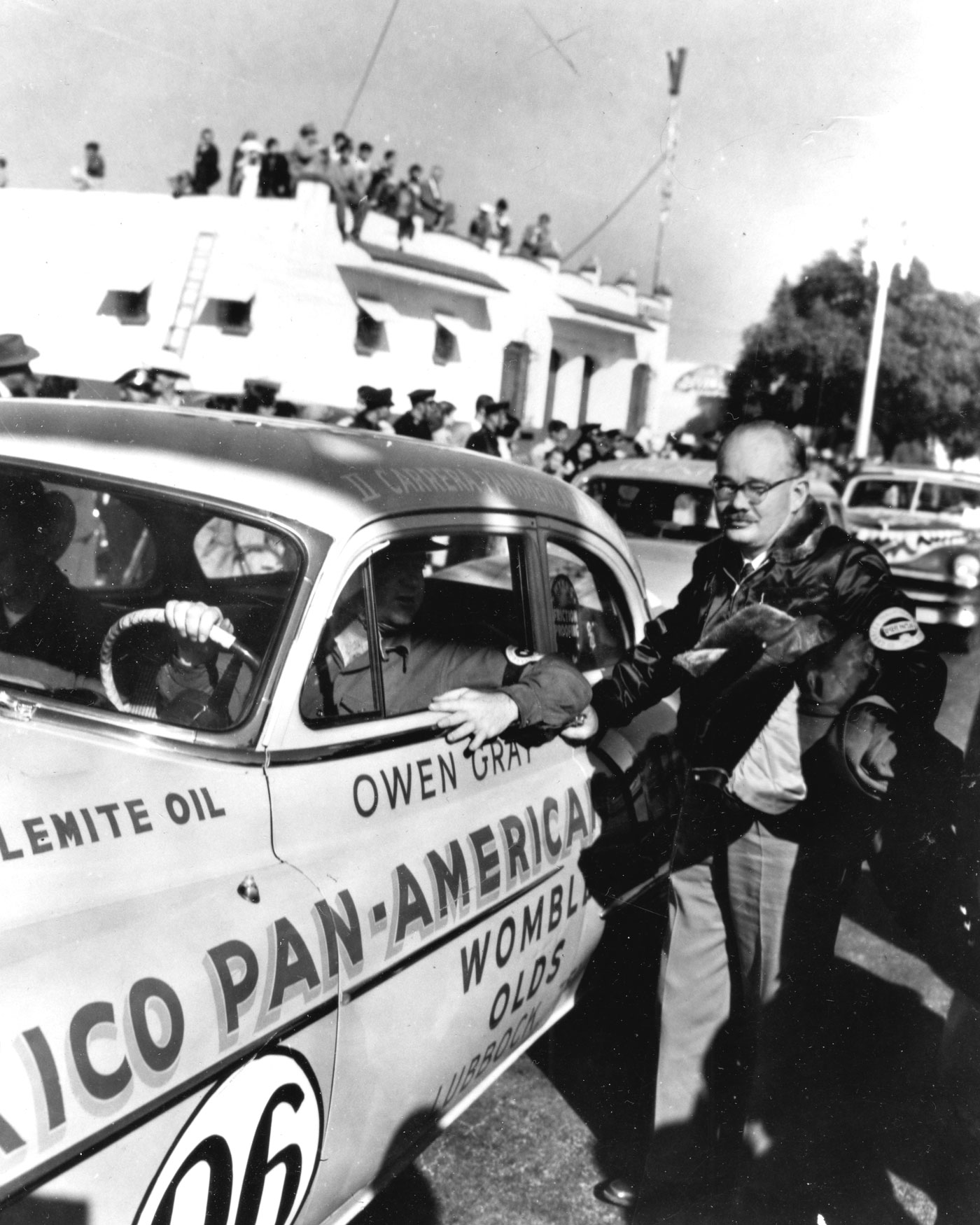
Possess an original copy of Issue 1 (Volume 1, Issue 1). I was born June 2, 1947. A friend thought it appropriate that I possess it.
Many thanks to Pete Vack and Jim Sitz for a wonderfully illuminating article. I’m looking forward to the next installment.
Thank you for this Pete and Jim. This is what makes Veloce Today a must read for enthusiasts.
Wonderful insight to one of the great American periodicals and preserver of racing history! It’s also evocative of a time unlike any other, of which some of us are – seemingly – the last survivors. ‘loved part 1!
Excellent article! But please list the editions in those early, partial years of Road and Track, so that I won’t spend the rest of my life scouring the world for editions that never existed. Thank you.
Love this article’s history. I will be waiting to read about the May 1953 issue as my father’s 1937 SS 100 car was on the cover.
I’m most interested in the next part when it comes to the purchase of the life work of famous German photographer Kurt Woerner who was awarded to bear the tittle Leica Studio.
Martin Schroeder
In the late 50s I saw a classified ad in the San Diego paper for an exotic Italian car for sale. I had to follow up so I called and that evening met Bill Brehaut. He gave me a ride in a fantastic Alfa 6C2500SS coupe and I was hooked for life. The price of the car was about $2000 and working as a box boy would not support such a purchase. However over the next couple years I visited with Bill and saved my money. Finally he found me a car I could afford. I bought a well used Alfa 6C2500SS Farina convertible. My friend Gerry Sullivan joined me in the search and he bought a Fiat 8V coupe that was previously owned by racer Lorenzo Bandini. We enjoyed our college years by driving these two exotics to San Diego State College on weekdays and on car events on weekends. Those were the days! Thanks Bill for starting Road and Track.
Amazing! Absolutely amazing! In 1947 having a young boyhood friend who had bought R & T, Vol. – #1; and helping him pour through it on his mother’s kitchen table. I was “hooked”! I knew about Billingsley; but not Brehaut! Fabulous job , Jim! Thank you Pete! I look forward for more!
Just a note on price: that $3.00 subscription that went largely unfulfilled in 1947 represents $35 in today’s dollars. The $.25 per issue cost would be $2.95. About what you’d expect.
I started buying my first issues of R&T at age 13 in 1966. It was a glorious era for the magazine, and for the Italian cars I was beginning to hooked on.
What a fascinating story, well done Peter and Jim. I certainly learnt a lot there. My introduction was later on when my uncle handed down many issues from the 1960`s. I would read and reread all the great stories of Ken Miles and Shelby American and marvel at all the great photographs. These magazines are automotive treasures, looking forward to part 2.
I arrived a little late to the party as my first R&T purchase was in the mid 50s but it was mind blowing. There was a whole world that I knew nothing about and I desperately needed to know more. My “collection” of R&T could not follow me as in those years I seemed to always be moving. Much later at the Monterey Historics there was an R&T subscription booth that had bound volumes of reproduced early magazines covering June 1947 to October 1950 so I bought the last one they had for $10. That is now my R&T collection and it is a treasure.
I remember getting the first issue on the newsstands and how classy it was even then.
Thank you very much, Jim and Pete !
From Walt Carroll:
Hello Peter! The Wonderful Story of the Early Years of R&T is just RIGHT. I was an Army brat at Fort Bragg, NC. The PX newstand was filled with all the then current hot rod stuff. In 1952, A kid from California brought copies of Road and Track to school for us to read. It was a beautiful magazine, there was no indication that this was an early effort, every article, every photo was perfect as far as we were concerned. One of my buddies fathers was the PX manager. We showed him R & T. He read it, he liked it, he ordered it for the PX. The Good word was beginning to spread from base to base. Being confined to a base, made it fanciful, even more so. Thank You for bringing this Amazing Archive forward. There are so many out there, recent generations, that have not a clue about what went on before. You have given us “The Dead Sea Scrolls” of Automobilia. Thank You Very much Peter, Dennis, John and Elaine.
Walt Carroll
Jim: I’d like to hear more about the Harry Morrow connection with R&T … you must have some great poop on that era … he, he, he.
My R&T archive only goes back to December 1950 (Vol. 2, Issue 5), and I am guilty of simply presuming that Mr. and Mrs. Bond were the founders and editors from Day #1. So, Jim Sitz has again enlightened me – as he has done a number of the times over the years that I have been privileged to know him. I have truly valued and treasured each issue of R&T over the years, and my fairly complete archive – especially over the 50’s and 60’s – has continued to be an intriguing and useful resource.
I appiccate the insight from this article, and am looking forward to next week’s issue.
Thank you Pete and Jim on the birth of Road and Track. We owe much to the ‘Volunteers’, operated on faith, enthusiasm, and personal resources to sustain and nurture a publication so easily could have suffered death at infancy. Upon reading the article, I reflected back to those days before ‘6-hours ago’ world wide publications, and Uncle Tom McCahill at Mechanix Illustrated was my source of automotive news. I then proceeded to reach for my copy of ROAD and TRACK, June 1947. On its editorial: Every issue of ROAD and TRACK magazine is to be dedicated to the automotive enthusiast. These missionary words guided ROAD and TRACK to be a eminent publication.
Who better than Jim Sitz, a researcher (and photographer) par excellence, to write about the early history of R&T? He was the go-to guy for the ’50s and ’60s chapters of Yanks at Le Mans and made a huge contribution. Everyone used his incredible memory – and note cards – to fact check and learn at the feet of the master on that period, including his friend Phil Hill….”Jim, what car was I driving at….?” Once again, velocetoday has done a great service to history, and to exhaust-pipe retentive enthusiasts like me :-). Well done Pete and Jim. TC
As a kid how I loved those Henry Manny race reports – all the gen you could hope for all be it about eight weeks late. I even got his autograph (an H with a straight line and an M with a straight line) at the USGP at Watkins Glen in 1968. I was going to ask Jochen Rindt but he frankly looked very unfriendly…..